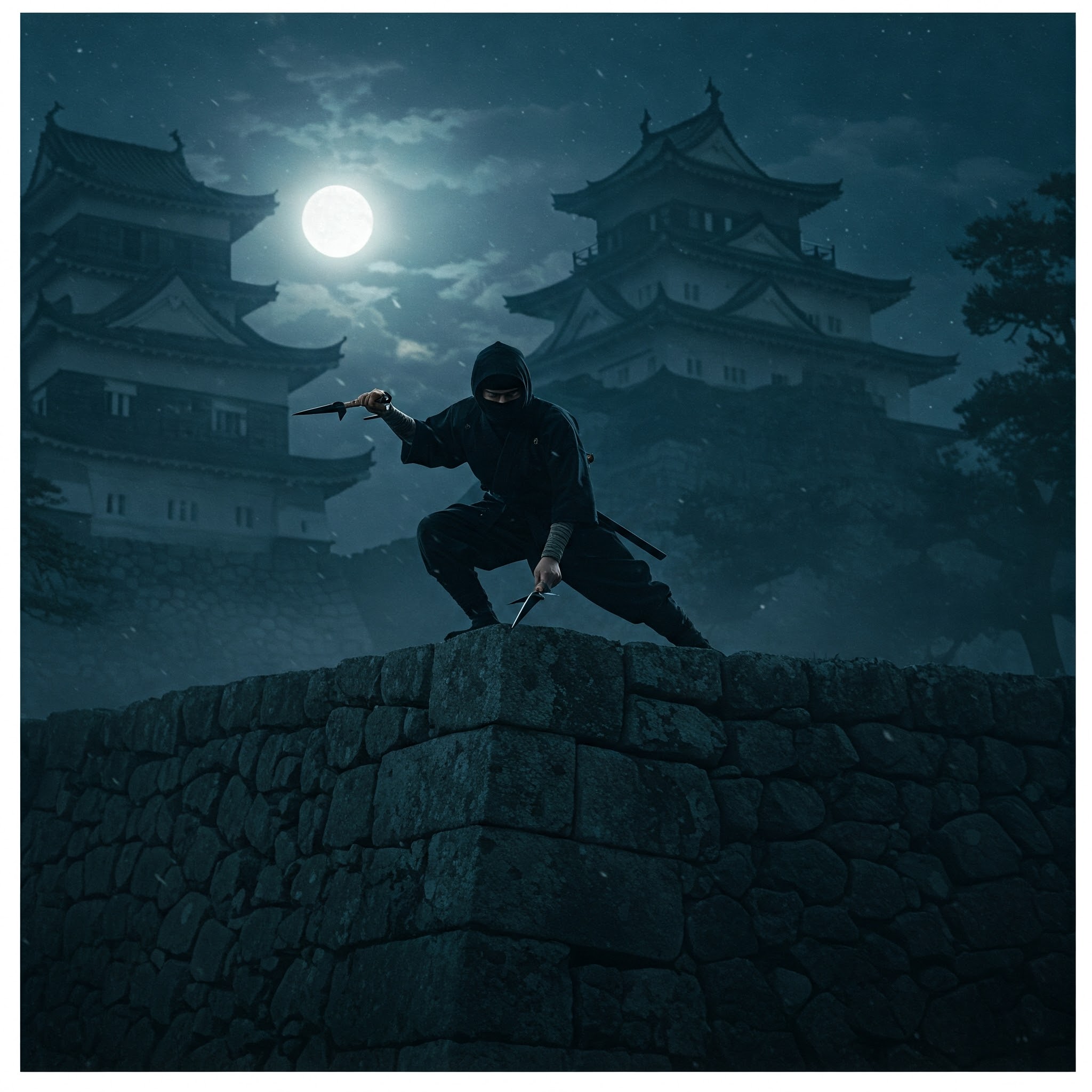忍者の「苦無」――その知られざるエピソードと多彩な使い道
忍者といえば、手裏剣や忍刀を思い浮かべる者も多いじゃろう。しかし、忍者の装備の中には、もっと多用途で実用的な武器が存在しておる。それが「苦無(くない)」じゃ。
苦無はただの武器ではなく、忍びがあらゆる状況に対応するための万能道具として活用されていたのじゃ。その知られざるエピソードと使い道について、詳しく紐解いていこう。
苦無とは何か?
苦無とは、本来、大工や職人が使用していた「たがね(鑿)」のような道具が起源とされておる。鉄製で、刃物のように鋭利ではなく、幅広の刃と握りやすい柄を持つ形状をしておる。全長は短いもの(10cm前後)から長いもの(30cm以上)まであり、用途に応じて使い分けられておった。
一般的な苦無の特徴は以下の通りじゃ:
- 刃が鋭利ではない: 切るよりも突く、打つ、削るといった用途が多い。
- 頑丈な鉄製: 壊れにくく、さまざまな用途に耐えられる。
- 先が尖っている: 突き刺したり、こじ開けたりするのに適している。
- 柄の端に穴がある: 紐を通して持ち運ぶ、投げる、罠を仕掛けるのに便利。
さて、この苦無を忍者たちはどのように使っておったのか?
苦無の多彩な使い道
① 武器としての苦無
苦無は忍者にとって、近接戦闘での武器としても使える道具であった。刃は鋭くないが、頑丈なため相手を殴る、突く、投げるといった使い方ができる。
また、刀を持たぬ忍者が万が一敵に襲われた際、苦無を短剣代わりに用いることもあった。特に、暗殺ではなく護身のための武器として重宝されたのじゃ。
② 道具としての苦無
忍者は戦うだけではなく、情報を集めたり、敵地に潜入したりするのが本分じゃ。苦無はそのための道具としても極めて優秀であった。
- 壁や扉を削る: 密かに侵入するために、木や土壁を削り、穴を開ける。
- 鍵の隙間に差し込みこじ開ける: 鍵開けの道具としても使用可能。
- 足場を作る: 壁に打ち込み、足をかけることで登る補助具として使う。
- 杭として使う: 地面に固定し、縄を結んで足場やトラップを作る。
③ 手裏剣のように投げる
一部の忍者は、苦無を投げて攻撃する技術も持っておった。ただし、手裏剣と違い、重く大きいため、遠距離の敵を仕留めるというよりも、相手の動きを止めたり、注意を引くために使われた。
④ 火薬との併用
苦無の柄の部分に火薬を仕込むことで、煙幕や爆発を発生させることもあったとされておる。敵の目をくらませるために投げつけ、爆発とともにその場を離れるのじゃ。
⑤ 罠としての活用
苦無を地面や木に固定し、ロープを張って罠を仕掛けることも可能じゃ。例えば、敵が足をかけると転倒する罠や、一定の力が加わると飛び出す仕掛けなど、アイデア次第で多様な用途に使われたのじゃ。
苦無にまつわる知られざるエピソード
嘘か誠か、こんな話も残っておる。
◆ 忍者の証としての苦無
一説によると、忍者は「苦無を持つ者こそが忍びである」と考えていたとも言われておる。苦無は武器であると同時に、忍者としての象徴的な道具であり、持ち歩くことでその身分を示すものでもあったそうじゃ。
◆ 旅人に偽装するための道具
忍者は時に、鍛冶屋や農民に変装して行動することがあった。その際、苦無は「仕事道具」として持ち歩くのに適していた。旅の途中で捕まったとしても、苦無があれば「自分は職人であり、忍者ではない」と言い訳できるので、疑われにくかったのじゃ。
◆ 忍者の墓標としての苦無
忍びの者が密かに亡くなった際、仲間が遺体を埋め、目印として苦無を地面に突き刺したとも言われておる。普通の墓を作るわけにはいかぬ忍者たちの、独自の弔いの方法であったのかもしれぬな。
まとめ
苦無は、ただの武器ではなく、忍者が生き延びるための万能ツールであった。戦いだけでなく、潜入や偵察、工作、罠作りなど、あらゆる場面で活躍する道具として、忍びたちの必須装備であったのじゃ。
忍者といえば手裏剣のイメージが強いが、実際には苦無こそが最も忍者らしい道具の一つだったと言えるじゃろう。忍びの世界の奥深さを、ぜひ感じてほしいものじゃな。
【以下英語版】【English version below】
The Secret Stories and Versatile Uses of the Ninja “Kunai”
When people think of ninja, weapons like shuriken and ninjatō often come to mind. However, among the ninja’s arsenal, there was an even more versatile and practical tool—the kunai.
The kunai was not just a weapon; it was a multi-purpose tool that allowed ninja to adapt to various situations. Let us delve into its lesser-known stories and wide range of uses.
What is a Kunai?
The kunai is believed to have originated from chisels or trowels used by craftsmen and masons. It was made of iron, not particularly sharp like a knife, but sturdy, with a broad blade and an easy-to-grip handle.
The typical characteristics of a kunai are:
- Not razor-sharp – It was mainly used for stabbing, striking, or carving rather than cutting.
- Made of durable iron – Sturdy enough for various practical uses.
- Pointed tip – Suitable for stabbing, prying open objects, or creating small openings.
- A hole in the handle – This allowed ninja to attach a rope for throwing, securing, or setting traps.
Now, how did ninja actually use this tool?
The Many Uses of the Kunai
1. Kunai as a Weapon
While primarily a tool, the kunai could also be used in combat. Since it wasn’t as sharp as a sword, it was used for striking, stabbing, or even throwing.
Ninja, who often traveled without carrying swords, would sometimes use kunai as a substitute dagger for self-defense rather than assassination.
2. Kunai as a Tool
Ninja were not only warriors but also spies who gathered intelligence and infiltrated enemy territories. The kunai was an essential multi-purpose tool for such missions.
- Carving through walls and doors – Used to quietly dig through wooden or earthen walls to create entry points.
- Prying open locks – The thin edge of the kunai was useful for breaking locks.
- Creating footholds – It could be driven into walls to serve as a climbing aid.
- Used as a stake – By securing it in the ground, ninja could tie ropes to set traps or make footbridges.
3. Thrown Like a Shuriken
Some ninja developed the skill to throw kunai as a distraction or to injure an opponent. Unlike lightweight shuriken, the kunai’s heavier weight made it more suited for breaking an enemy’s focus rather than causing fatal damage.
4. Combined with Gunpowder
It is said that ninja sometimes hid gunpowder in the handle of the kunai. By throwing it and igniting the fuse, they could create smoke screens or small explosions to escape.
5. Used in Traps
Kunai were also employed in various trap mechanisms. For example, ninja could secure kunai in the ground with a rope attached to trip an enemy or create a tension-triggered mechanism that would launch the kunai when disturbed.
Lesser-Known Stories About Kunai
Truth or fiction, such tales have been passed down through generations.
◆ The Kunai as a Symbol of Ninja Identity
Some say that possessing a kunai was a sign of being a ninja. It was not just a weapon but an emblem of the ninja profession. To carry a kunai meant one belonged to the world of espionage and covert operations.
◆ Disguised as a Traveler’s Tool
Ninja often disguised themselves as blacksmiths or farmers while traveling. The kunai, resembling a common tool, allowed them to blend in without drawing suspicion. If caught, they could claim to be mere craftsmen rather than warriors.
◆ Kunai as a Ninja’s Gravestone
One tale suggests that when a ninja died in secret, their comrades would bury the body and mark the grave with a kunai instead of a traditional headstone. Since ninja could not have formal burials, this may have been their way of honoring fallen comrades.
Conclusion
The kunai was far more than just a weapon—it was a survival tool essential to the ninja’s way of life. It was used for combat, infiltration, intelligence gathering, and even trap-making, proving its incredible versatility.
Although shuriken are more famous in popular culture, the kunai was likely one of the most practical and frequently used tools of real ninja.
Next time you think of ninja, remember that their true strength lay not just in their weapons but in their ingenuity and adaptability—qualities embodied by the kunai.



